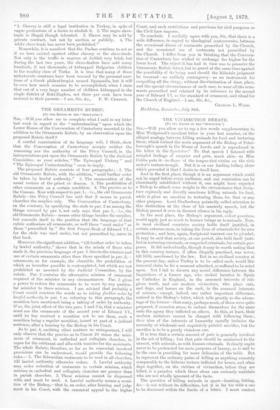THE ORNAMENTS RUBRIC.
[TO THE EDITOR OF THE "SPECTATOR.")
you allow me to complete what I said in my letter last week iu regard to the " understanding" upon which the Lower House of the Convocation of Canterbury assented to the addition to the Ornaments Rubric, by an observation upon the proposed Rubric itself ?
A careful examination of its language will, I think, show that the Convocation of Canterbury accepts neither the reasoning nor the authority of the Privy Council, in the interpretations put upon the Ornaments Rubric by the Judicial Committee, as your articles, " The Episcopal Victory " and " The Episcopal Understanding " seem to imply.
The proposed Rubric consists of four paragraphs :-1. The old Ornaments Rubric, with the addition, " until further order be taken by lawful authority." 2. The enumeration of the usual vesture of the priest or deacon. 3. The prohibition of other ornaments on a certain condition. 4. The proviso as to the Canons. Now with respect to par. 1,—i.e., the old Ornaments Rubric—the Privy Council has said that it means in parish churches the surplice only. The Convocation of Canterbury, on the contrary, by specifying the stole iu par. 2 as among the things covered by par. 1, not only says that par. 1,—i.e., the old Ornaments Rubric—means other things besides the surplice, but commits itself to the position that the language of that rubric authorises all ornaments, as well those " used under " as those " prescribed by " the first Prayer-Book of Edward VI. ; for the stole was used under, but not prescribed by, name in that book.
Moreover, the significant addition, "till further order be taken by lawful authority," shows that in the minds of those who made it, the previous language of par. 1 directs the retainer and use of certain ornaments other than those specified in par. 2,— ornaments, as for example, the chasuble, the prohibition of which as hereafter possible is contemplated, but which are not prohibited as asserted by the Judicial Committee, by the rubric. Par. 2 contains the alternative minima of ornament required of the minister in any circumstances. Par. 3 gives a power to reduce the ornaments to be worn by any particu- lar minister to these minima. I am advised that probably a Court would construe the words as to taking further alder by lawful authority iu par. 1 as referring to this paragraph, the monition here mentioned being a taking of order by authority. If so, the joint effect of the two pars. 1 and 3 is, that a minister must use the ornaments of the second year of Edward VI., until he has received a monition not to use them, such a monition being a regular monition, issued as part of a judicial sentence, after a hearing by the Bishop iu his Court.
As to par. 4, omitting other matters as unimportant, I will only observe that the proviso as to Canon 24 raises the mini- mum of ornament, in cathedral and collegiate churches, to copes for the celebrant and albs with tunicles for the assistants. The whole Rubric, therefore, so far as its somewhol involved provisions can be understood, would provide the following rules :-1. The Edwardian vestments to be used in all churches, till lawful authority otherwise orders. 2. Lawful authority may order reduction of vestments to certain minima, which minima in cathedral and collegiate churches are greater than in parish churches. 3. These minima cannot be dispensed with, and must be used. 4. Lawful authority means a moni- tion of the Bishop,—that is, an order, after hearing and judg- ,ment in his Court, with the canonical appeal to the higher
Court, and such restrictions and provisoes for civil purposes as the Civil Law imposes.
To conclude. I cordially agree with you, Sir, that there is a wide difference, in regard to theological controversies, between the occasional disuse of vestments prescribed by the Church, and the occasional use of vestments not prescribed by the Church. I differ from you in thinking that the Convoca- tion of Canterbury has wished to exchange the higher for the lower level. The object it has had in view was to preserve the. Ornaments Rubric intact, but to guard at the same time against the possibility of its being used should the Ridsdale judgment be reversed—no unlikely contingency—as an instrument for compelling all the clergy, without discrimination of time, place, and the special circumstances of each case, to wear all the orna- ments prescribed and retained by its reference to the second year of Edward VI. as the standard of ornament, and ritual for the Church of England.—I am, Sir, &c., CHARLES L. WOOD. Heckleton, Doncaster, Tuly 30th.


































 Previous page
Previous page